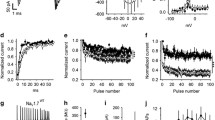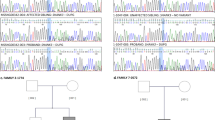Abstract
Background
The pathogenesis of autism spectrum disorder (ASD) is not fully clarified. Next-generation sequencing technologies have greatly enhanced the identification of new genes associated with ASD. Variants in ANK2 gene are known to correlate with a broad spectrum of clinical cardiac phenotypes, but, more recently, it has also been pointed out as a candidate gene for the etiology of ASD.
Case presentation
We report the case of a female patient with ASD and epilepsy in whom clinical exome sequencing was performed for etiological enlightenment. A heterozygous variant of uncertain significance was identified in the ANK2 gene: c.3412C > T p.(Arg1138Ter). The child was submitted to a formal cardiac evaluation, ruling out cardiovascular abnormalities. The genetic variant was searched in her parents and was negative in both, suggesting a de novo variant, which favors its pathogenicity.
Conclusions
We recognize the challenge of assessing variant pathogenicity in candidate genes for ASD, and ANK2 gene is currently not associated with neurodevelopmental disorders in the Online Mendelian Inheritance in Man database. Nonetheless, our case can be added to other published reports of de novo ANK2 variants in children with ASD and neurological phenotypes (including seizures), some without cardiac impairment. Hopefully, this study provides a more detailed phenotypical description that is often lacking, and it may contribute to a better understanding of the association between ANK2 and ASD.
Similar content being viewed by others
Background
Autism spectrum disorder (ASD) is a neurodevelopmental disorder characterized by social and communication impairment [1].
The pathogenesis of ASD is not fully clarified. It seems that it is caused by genetic factors affecting neural connectivity, consequently impairing social communication development and leading to stereotypies and restricted interests [1, 2]. It has been hypothesized that the heterogeneous clinical presentation of ASD results from the interaction between multiple genes or gene combinations as well as epigenetic factors and exposure to environmental modifiers [3].
Next-generation sequencing technologies have greatly enhanced the identification of new genes associated with ASD. Recently, ANK2 gene has also been pointed out as a candidate gene for the etiology of ASD [4,5,6].
With this study, the authors aim to report the detection of a de novo heterozygous ANK2 variant in a child with ASD and epilepsy, providing a detailed clinical description.
Case presentation
We report the case of a female patient, born after a non-eventful gestation. Prenatal ultrasounds were described as normal. She was born via cesarean at 39 weeks, with Apgar score 9/10 and appropriate birth size. Newborn screening tests and perinatal period were unremarkable. She is the only child of non-consanguineous parents and family history was non-contributory.
At 2 months old, she was admitted to the Pediatric ward due to focal clonic seizures of her left lower limb, lasting approximately 10 s, which did not cease by pressing the limb and had been occurring either during sleep or awake, two to four times a day, for at least 1 week. Laboratory blood tests including blood count, inflammatory parameters (C-reactive protein), muscle enzymes, glucose and electrolytes did not show relevant abnormalities. Electroencephalography was performed during hospital stay and revealed normal background with interictal and ictal epileptiform discharges restricted to the midline central and right central regions (Cz-P4). No structural brain anomalies were identified by neuroimaging. She was initially treated with levetiracetam 10 mg/kg/dose twice daily and frequency of seizures was reduced to one/two times a day. Levetiracetam was progressively increased to 30 mg/kg/dose, but she maintained the same periodicity of seizures. On the third week of treatment, antiseizure medication was changed to phenobarbital (3 mg/kg/day in 3 divided doses). During the following week, she presented three brief episodes of increased muscle tone in the left lower limb, lasting approximately five seconds. Since then, no more episodes of seizure were described.
At 2 years old, she was referred to the Pediatric Neurodevelopment department since she was unable to achieve the language developmental milestones for her age. She displayed an abnormal gait pattern (toe walking) since she was 20 months old. She presented difficulties on establishing eye contact, following simple instructions or responding consistently to her name. She also struggled on joint attention and symbolic play. Her speech was characterized mostly by jargon with no intelligible words. She was unable to name body parts or objects in pictures. Her mother reported an obsession with water and keyboards. According to her school daycare educator, she engaged in a more passive play with her peers. Her daycare educator also reported some difficulty with specific textures while playing. There was no history of unusual eating habits.
On physical examination, she displayed some peculiar facial features including a large mouth with widely spaced teeth. Head growth evaluation was normal, including her current head circumference. Neurological examination was unremarkable aside from toe walking. Auditory evoked potentials were performed and displayed normal results. Diagnosis of ASD was confirmed using the criteria from the Diagnostic and Statistical Manual of Mental Disorders, fifth edition [1]. She was started on multimodality interventions, namely speech-language and occupational therapies (with sensory integration approach). During her follow-up, she made progresses regarding social interaction and autonomy, though she maintained an important speech delay. At the age of 3 years, electroencephalography was repeated and did not show abnormalities; at this point she began a progressive withdrawal of phenobarbital, without recurrence of seizures. She only began to speak clearly in simple sentences at the age of four. On her latest evaluation in the Pediatric Neurodevelopment Department, at the age of seven, she revealed a very good memory capacity, she could read simple words and showed a favorable improvement in verbal and non-verbal interactions. Subjectively, she appears to have a normal cognitive function. She currently attends the first grade of elementary school, and she has interest and good performance in Mathematics according to her teacher.
Additional evaluation included array comparative genomic hybridization (aCGH) and Angelman syndrome methylation analysis which were normal. A clinical exome sequencing (CES) was performed, and a heterozygous variant of uncertain significance was identified in the ANK2 gene (NM_001148.5): c.3412C > T p.(Arg1138Ter) (Fig. 1A). The genetic variant was then searched in her parents and was negative in both, suggesting a de novo variant (Fig. 1B).
The child was submitted to a formal cardiac evaluation, ruling out cardiovascular abnormalities.
Conclusions
Etiological assessment plays an important role in management of ASD, since it allows a more detailed information on prognosis, comorbidities and genetic counseling. In patients where clinical history, physical examination, aCGH and molecular genetic testing for fragile X syndrome are inconclusive, the next step on etiological assessment is usually a trio-based whole exome sequencing or CES [1]. In our patient, we decided to perform a CES for etiological enlightenment, unveiling a ANK2 gene variant.
It is vastly recognized in current literature that loss-of-function variants in ANK2 can result in a broad spectrum of clinical cardiac phenotypes including Long QT syndrome 4 and Ankyrin-B Syndrome (OMIM: 600919) [6]. According to animal model experiments, ANK2 encodes an ankyrin protein involved in synaptic stability. Studies in mice have shown that ANK2 pathogenic variants may increase axon branching and ectopic connectivity [7]. Due to its interactions with the voltage-gated CaV2.1 calcium channel, ANK2 variants had been associated to occurrence of seizures [8]. Recently, ANK2 gene has also been linked to the etiology of ASD [4,5,6]. However, this gene is currently not associated with neurodevelopmental disorders in the Online Mendelian Inheritance in Man (OMIM) database.
We recognize the challenge of assessing variant pathogenicity in candidate genes for ASD. The reported ANK2 variant was formally classified as a variant of uncertain significance. However, it was absent in parents and there was not family history, which favors its pathogenicity. Our study provides a detailed phenotypical description that is often lacking; thus, it can be added to other published reports correlating de novo ANK2 variants with ASD and neurological phenotypes (including seizures), some without cardiac impairment. Ji et al. reported a de novo heterozygous nonsense ANK2 variant in a 5-year-old female with seizures and neurodevelopmental impairment (severe global developmental delay and aggressive behavior) (4); she also displayed microcephaly, unlike our patient.
In summary, we report a de novo heterozygous ANK2 variant detected in a child with ASD and epilepsy. Additional research is required to better understand the association between ANK2 and ASD, as well as its implications on phenotypic spectrum.
Availability of data and materials
Not applicable.
Abbreviations
- aCGH:
-
Array comparative genomic hybridization
- ASD:
-
Autism spectrum disorder
- CES:
-
Clinical exome sequencing
- OMIM:
-
Online Mendelian Inheritance in Man
References
Hyman SL, Levy SE, Myers SM, Council on Children with Disabilities, Section on Developmental and Behavioral Pediatrics (2020) Identification, evaluation, and management of children with autism spectrum disorder. Pediatrics. https://doi.org/10.1542/peds.2019-3447
Tian J, Gao X, Yang L (2022) Repetitive restricted behaviors in autism spectrum disorder: from mechanism to development of therapeutics. Front Neurosci. https://doi.org/10.3389/fnins.2022.780407
Oztenekecioglu B, Mavis M, Osum M, Kalkan R (2021) Genetic and epigenetic alterations in autism spectrum disorder. Glob Med Genet. https://doi.org/10.1055/s-0041-1735540
Ji J, Shen L, Bootwalla M, Quindipan C, Tatarinova T, Maglinte DT et al (2019) A semiautomated whole-exome sequencing workflow leads to increased diagnostic yield and identification of novel candidate variants. Cold Spring Harb Mol Case Stud. https://doi.org/10.1101/mcs.a003756
Kawano S, Baba M, Fukushima H, Miura D, Hashimoto H, Nakazawa T (2022) Autism-associated ANK2 regulates embryonic neurodevelopment. Biochem Biophys Res Commun. https://doi.org/10.1016/j.bbrc.2022.03.058
York NS, Sanchez-Arias JC, McAdam ACH, Rivera JE, Arbour LT, Swayne LA (2022) Mechanisms underlying the role of ankyrin-B in cardiac and neurological health and disease. Front Cardiovasc Med. https://doi.org/10.3389/fcvm.2022.964675
Yang R, Walder-Christensen KK, Kim N, Wu D, Lorenzo DN, Badea A et al (2019) ANK2 autism mutation targeting giant ankyrin-B promotes axon branching and ectopic connectivity. Proc Natl Acad Sci USA. https://doi.org/10.1073/pnas.1904348116
Choi CSW, Souza IA, Sanchez-Arias JC, Zamponi GW, Arbour LT, Swayne LA (2019) Ankyrin B and Ankyrin B variants differentially modulate intracellular and surface Cav2.1 levels. Mol Brain. https://doi.org/10.1186/s13041-019-0494-8
Acknowledgements
Not applicable.
Funding
Not applicable.
Author information
Authors and Affiliations
Contributions
CS and ML conceived the study and supervised. CGM and RQ wrote the manuscript. LL and MG contributed to data and reviewed the manuscript. All authors read and approved the final manuscript.
Corresponding author
Ethics declarations
Ethics approval and consent to participate
Not applicable.
Consent for publication
Written informed consent was obtained from a legally authorized representative of the patient for publication of this case report.
Competing interests
The authors declare that they have no competing interests.
Additional information
Publisher's Note
Springer Nature remains neutral with regard to jurisdictional claims in published maps and institutional affiliations.
Rights and permissions
Open Access This article is licensed under a Creative Commons Attribution 4.0 International License, which permits use, sharing, adaptation, distribution and reproduction in any medium or format, as long as you give appropriate credit to the original author(s) and the source, provide a link to the Creative Commons licence, and indicate if changes were made. The images or other third party material in this article are included in the article's Creative Commons licence, unless indicated otherwise in a credit line to the material. If material is not included in the article's Creative Commons licence and your intended use is not permitted by statutory regulation or exceeds the permitted use, you will need to obtain permission directly from the copyright holder. To view a copy of this licence, visit http://creativecommons.org/licenses/by/4.0/.
About this article
Cite this article
Morais, C.G., Quental, R., Lourenço, L. et al. Detection of a de novo heterozygous ANK2 variant in a child with autism spectrum disorder and epilepsy: a case report. Egypt J Med Hum Genet 24, 9 (2023). https://doi.org/10.1186/s43042-023-00389-y
Received:
Accepted:
Published:
DOI: https://doi.org/10.1186/s43042-023-00389-y





